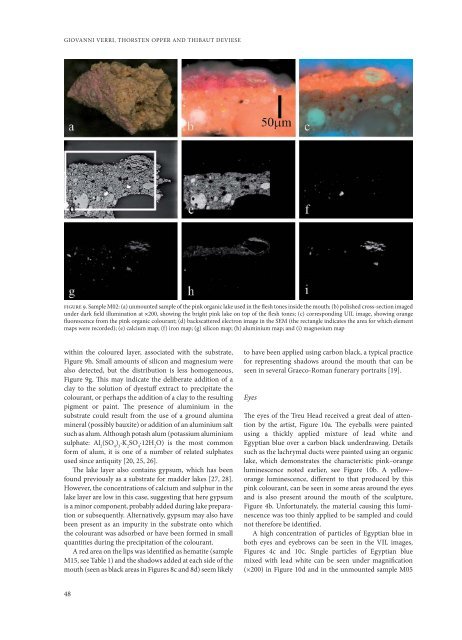You also want an ePaper? Increase the reach of your titles
YUMPU automatically turns print PDFs into web optimized ePapers that Google loves.
GIOVANNI VERRI, THORSTEN OPPER AND THIBAUT DEVIESE<br />
figure 9. Sample M02: (a) unmounted sample of the pink organic lake used in the flesh tones inside the mouth; (b) polished cross-section imaged<br />
under dark field illumination at �200, showing the bright pink lake on top of the flesh tones; (c) corresponding UIL image, showing orange<br />
fluorescence from the pink organic colourant; (d) backscattered electron image in the SEM (the rectangle indicates the area for which element<br />
maps were recorded); (e) calcium map; (f) iron map; (g) silicon map; (h) aluminium map; and (i) magnesium map<br />
within the coloured layer, associated with the substrate,<br />
Figure 9h. Small amounts of silicon and magnesium were<br />
also detected, but the distribution is less homogeneous,<br />
Figure 9g. This may indicate the deliberate addition of a<br />
clay to the solution of dyestuff extract to precipitate the<br />
colourant, or perhaps the addition of a clay to the resulting<br />
pigment or paint. <strong>The</strong> presence of aluminium in the<br />
substrate could result from the use of a ground alumina<br />
mineral (possibly bauxite) or addition of an aluminium salt<br />
such as alum. Although potash alum (potassium aluminium<br />
sulphate: Al 2 (SO 4 ) 3 ·K 2 SO 4 ·12H 2 O) is the most common<br />
form of alum, it is one of a number of related sulphates<br />
used since antiquity [20, 25, 26].<br />
<strong>The</strong> lake layer also contains gypsum, which has been<br />
found previously as a substrate for madder lakes [27, 28].<br />
However, the concentrations of calcium and sulphur in the<br />
lake layer are low in this case, suggesting that here gypsum<br />
is a minor component, probably added during lake preparation<br />
or subsequently. Alternatively, gypsum may also have<br />
been present as an impurity in the substrate onto which<br />
the colourant was adsorbed or have been formed in small<br />
quantities during the precipitation of the colourant.<br />
A red area on the lips was identified as hematite (sample<br />
M15, see Table 1) and the shadows added at each side of the<br />
mouth (seen as black areas in Figures 8c and 8d) seem likely<br />
48<br />
to have been applied using carbon black, a typical practice<br />
for representing shadows around the mouth that can be<br />
seen in several Graeco-Roman funerary portraits [19].<br />
Eyes<br />
<strong>The</strong> eyes of the Treu Head received a great deal of attention<br />
by the artist, Figure 10a. <strong>The</strong> eyeballs were painted<br />
using a thickly applied mixture of lead white and<br />
Egyptian blue over a carbon black underdrawing. Details<br />
such as the lachrymal ducts were painted using an organic<br />
lake, which demonstrates the characteristic pink–orange<br />
luminescence noted earlier, see Figure 10b. A yellow–<br />
orange luminescence, different to that produced by this<br />
pink colourant, can be seen in some areas around the eyes<br />
and is also present around the mouth of the sculpture,<br />
Figure 4b. Unfortunately, the material causing this luminescence<br />
was too thinly applied to be sampled and could<br />
not therefore be identified.<br />
A high concentration of particles of Egyptian blue in<br />
both eyes and eyebrows can be seen in the VIL images,<br />
Figures 4c and 10c. Single particles of Egyptian blue<br />
mixed with lead white can be seen under magnification<br />
(×200) in Figure 10d and in the unmounted sample M05

















